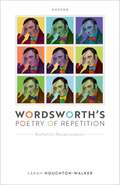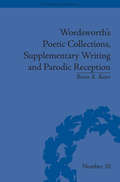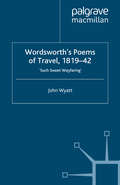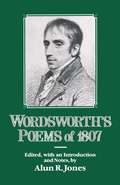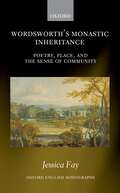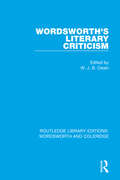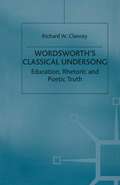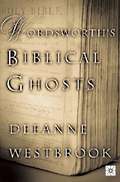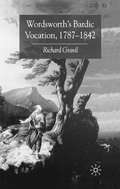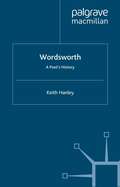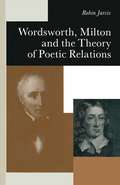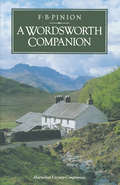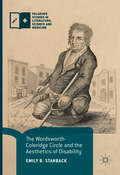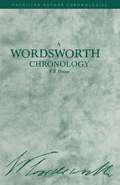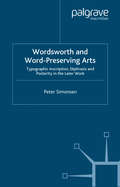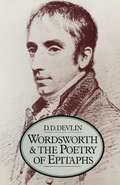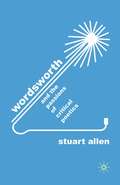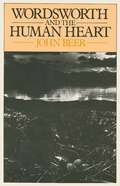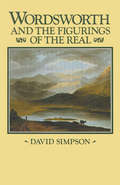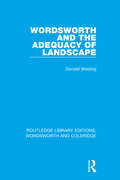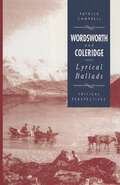- Table View
- List View
Wordsworth's Poetry of Repetition: Romantic Recapitulation
by Sarah Houghton-WalkerRepetition has connotations of something boring, or unoriginal, or lacking in poetic skill, but repetition - in several different senses - dominates Wordsworth's poetry. This book explores those moments of repetition, placing them in the early nineteenth century context from which they emerged, and teasing out through extended close attention to the poetry itself the complexities of repetition and recapitulation. Drawing on extensive close readings of Wordsworth's poetry, the book asks what it means to repeat, and how saying things again, often in a way which recognises both sameness and difference at the same time, is fundamental to Wordsworth's attempt to write what he called 'sincere' verse. By analysing instances of repetition and the conjunctions which facilitate recapitulation within Wordsworth's writing, the book attempts to understand the context, in terms of ideas of repetition, from which Wordsworth's works emerge, and to consider repetition in a broad range of senses - from repeated words and sounds within particular poems, to ideas of translation, allusion, and echo. Houghton-Walker also argues the importance of the element of difference within even apparently 'pure' repetition. Such difference might be in perception, attitude, or understanding, but for Wordsworth, the subtle relationship between instances of what seems to be the same experience illuminates the potential for poetry to portray simultaneously the specific and the universal: to hold within its lines both immediate and general truths at the same time.
Wordsworth's Poetic Collections, Supplementary Writing and Parodic Reception (The History of the Book)
by Brian R BatesWordsworth’s process of revision, his organization of poetic volumes and his supplementary writings are often seen as distinct from his poetic composition. Bates asserts that an analysis of these supplementary writings and paratexts are necessary to a full understanding of Wordsworth’s poetry.
Wordsworth's Poetic Collections, Supplementary Writing and Parodic Reception (The History of the Book #10)
by Brian R BatesWordsworth’s process of revision, his organization of poetic volumes and his supplementary writings are often seen as distinct from his poetic composition. Bates asserts that an analysis of these supplementary writings and paratexts are necessary to a full understanding of Wordsworth’s poetry.
Wordsworth's Poems of Travel 1819-1842: Such Sweet Wayfaring (Romanticism in Perspective:Texts, Cultures, Histories)
by J. WyattThere is a long-held view that Wordsworth's inspiration dried up before the age of forty. This book opposes that view by examining the substantial body of poetry written after his fiftieth year. The argument is that, in order to appreciate this work, much of which was inspired by itineraries in Britain and in Europe, we have to read the poems as they were first published. By adopting the perspective of the contemporary reader, Wordsworth's grand design can be appreciated.
Wordsworth's Monastic Inheritance: Poetry, Place, and the Sense of Community (Oxford English Monographs)
by Jessica FayThis is the first extended study of Wordsworth's complex, subtle, and often conflicted engagement with the material and cultural legacies of monasticism. It reveals that a set of topographical, antiquarian, and ecclesiastical sources consulted by Wordsworth between 1806 and 1822 provided extensive details of the routines, structures, landscapes, and architecture of the medieval monastic system. In addition to offering a new way of thinking about religious dimensions of Wordsworth's work and his views on Roman Catholicism, the book offers original insights into a range of important issues in his poetry and prose, including the historical resonances of the landscape, local attachment and memorialization, gardening and cultivation, Quakerism and silence, solitude and community, pastoral retreat and national identity. Wordsworth's interest in monastic history helps explain significant stylistic developments in his writing. In this often-neglected phase of his career, Wordsworth undertakes a series of generic experiments in order to craft poems capable of reformulating and refining taste; he adapts popular narrative forms and challenges pastoral conventions, creating difficult, austere poetry that, he hopes, will encourage contemplation and subdue readers' appetites for exciting narrative action. This book thus argues for the significance and innovative qualities of some of Wordsworth's most marginalized writings. It grants poems such as The White Doe of Rylstone, The Excursion, and Ecclesiastical Sketches the centrality Wordsworth believed they deserved, and reveals how Wordsworth's engagement with the monastic history of his local region inflected his radical strategies for the creation of taste.
Wordsworth's Monastic Inheritance: Poetry, Place, and the Sense of Community (Oxford English Monographs)
by Jessica FayThis is the first extended study of Wordsworth's complex, subtle, and often conflicted engagement with the material and cultural legacies of monasticism. It reveals that a set of topographical, antiquarian, and ecclesiastical sources consulted by Wordsworth between 1806 and 1822 provided extensive details of the routines, structures, landscapes, and architecture of the medieval monastic system. In addition to offering a new way of thinking about religious dimensions of Wordsworth's work and his views on Roman Catholicism, the book offers original insights into a range of important issues in his poetry and prose, including the historical resonances of the landscape, local attachment and memorialization, gardening and cultivation, Quakerism and silence, solitude and community, pastoral retreat and national identity. Wordsworth's interest in monastic history helps explain significant stylistic developments in his writing. In this often-neglected phase of his career, Wordsworth undertakes a series of generic experiments in order to craft poems capable of reformulating and refining taste; he adapts popular narrative forms and challenges pastoral conventions, creating difficult, austere poetry that, he hopes, will encourage contemplation and subdue readers' appetites for exciting narrative action. This book thus argues for the significance and innovative qualities of some of Wordsworth's most marginalized writings. It grants poems such as The White Doe of Rylstone, The Excursion, and Ecclesiastical Sketches the centrality Wordsworth believed they deserved, and reveals how Wordsworth's engagement with the monastic history of his local region inflected his radical strategies for the creation of taste.
Wordsworth's Literary Criticism (RLE: Wordsworth and Coleridge)
by W. J. B. OwenFirst published in 1974. Wordsworth, with Coleridge, is the major literary critic of the Romantic period. This volume assembles all of Wordsworth’s formal critical writings and a selection of critical comments from his correspondence. These documents are invaluable for Romantic poetry at large, and his theories — particularly on poetic diction, ordinary language and the nature of the creative process — inspired lively critical debate. This book discusses the nature and origin of Wordsworth’s criticism in general, and the literary tradition from which they sprang. The texts are succinctly annotated and there is a select bibliography. This book will be of interest to students of literature.
Wordsworth's Literary Criticism (RLE: Wordsworth and Coleridge)
by W. J. B. OwenFirst published in 1974. Wordsworth, with Coleridge, is the major literary critic of the Romantic period. This volume assembles all of Wordsworth’s formal critical writings and a selection of critical comments from his correspondence. These documents are invaluable for Romantic poetry at large, and his theories — particularly on poetic diction, ordinary language and the nature of the creative process — inspired lively critical debate. This book discusses the nature and origin of Wordsworth’s criticism in general, and the literary tradition from which they sprang. The texts are succinctly annotated and there is a select bibliography. This book will be of interest to students of literature.
Wordsworth's Classical Undersong: Education, Rhetoric and Poetic Truth
by Richard ClanceyWordsworth's classical education presents an amazing paradox. Gifted teachers trained him in the full rigours of classical Latin and Greek. But Wordsworth's schoolmasters were enlightened, liberal and advanced. They were committed to the Classics and to modern literature. In their enthusiasm they shared their volumes of contemporary poetry with Wordsworth. His was a holistic literary education. Wordsworth developed a profound love for the Classics and thus an enlightened zeal for a new poetry, a poetry capable of being compared with and even daring to compete with the Classical texts he so dearly loved. Richard Clancey's meticulously researched study presents new biographical information on Wordsworth's classical education and new facts about the education of his teachers.
Wordsworth's Biblical Ghosts
by D. WestbrookThe Bible serves Wordsworth as a basis for his poetry and poetics, providing language, images, figures, and importantly, a paradigm of poetic genres. Working from three interrelated critical approaches - intertextuality, poetics, and metaphysics - Westbrook first analyzes Wordsworth's theory and practice as these reflect the New Testament doctrine of the Incarnation. Subsequent chapters consider Wordsworth's adaptation of biblical narrative forms - etymological tales, parables, and mystical allegories. Closing chapters examine some extraordinary linguistic innovations in Wordsworth's revisions of biblical apocalypse, techniques that permit the poet to express the ineffable and to reveal nothing.
Wordsworth’s Bardic Vocation, 1787–1842
by R. GravilFrom 1787 to 1842, Wordsworth was preoccupied with the themes of loss and death, and with 'natural piety' in the lives of people and nations. Beginning with his consciousness of the Bards and Druids of Cumbria, this book treats Wordsworth's oeuvre , including the 'Gothic' juvenilia, The Ruined Cottage , Lyrical Ballads , Poems in Two Volumes , The Excursion , and the Poems of 1842, as unified by a Bardic vocation, to bind 'the living and the dead' and to nurture 'the kind'.
Wordsworth: A Poet’s History
by K. HanleyWordsworth: A Poet's History examines the range of Wordsworth's poetry and criticism over the course of his career. It examines the writer and his works against the backdrop of revolutionary history, public, personal as well as political. The study foregrounds the ways in which Wordsworth's account of 'self-representation in poetic language' coils around and recoils from the linguistic traumas excited by the French Revolution. The book also examines Wordsworth's patriotism and the evolution of this as demonstrated in his poetry.
The Wordsworth-Coleridge Circle and the Aesthetics of Disability (Palgrave Studies in Literature, Science and Medicine)
by Emily B. StanbackThis book argues for the importance of disability to authors of the Wordsworth-Coleridge circle. By examining texts in a variety of genres — ranging from self-experimental medical texts to lyric poetry to metaphysical essays — Stanback demonstrates the extent to which non-normative embodiment was central to Romantic-era thought and Romantic-era aesthetics. The book reassesses well-known literary and medical works by such authors as William Wordsworth, Samuel Taylor Coleridge, and Humphry Davy, argues for the importance of lesser-studied work by authors including Charles Lamb and Thomas Beddoes, and introduces significant unpublished work by Tom Wedgwood.
Wordsworth and Word-Preserving Arts: Typographic Inscription, Ekphrasis and Posterity in the Later Work
by P. SimonsenBy looking at the later Wordsworth's ekphrastic writings about visual art and his increased awareness of the printed dimension of his work, Simonsen calls attention to what is uniquely exciting about this neglected body of work, and argues that it complicates traditional understandings of Wordsworth based on his so-called Great Decade.
Wordsworth and the Passions of Critical Poetics
by S. AllenThis scholarly study presents a new political Wordsworth: an artist interested in 'autonomous' poetry's redistribution of affect. No slave of Whig ideology, Wordsworth explores emotion for its generation of human experience and meaning. He renders poetry a critical instrument that, through acute feeling, can evaluate public and private life.
Wordsworth and the Figurings of the Real
by David SimpsonPerhaps the most powerful feature of the Romantic imagination is its ability to dissolve existing form and order and create it anew. The Romantic investigation of the functions of the imagination also leads to important insights concerning its problems and dangers. Because it separates the person experiencing it from others around him, the imagination introduces ways of seeing which cannot be assumed to be simply communicable or easily shared, and which have as their objects different forms or 'things'. These forms, or figures, risk becoming for their originators both vehicles of power, in so far as they do convince others of their reality, and limiting constructs of prefigured order, inhibiting their users from the perception of new relations and alternative meanings. When the figured becomes the real, there thus arise difficulties in both individual and social perceptions. Arguing from the stance that all perception takes place by a creative (and hence potentially divisive) assembly of images or qualities into things, David Simpson shows that the analysis of figurative representation in Wordsworth's writing is of central importance to his idea of the human mind, and the way in which it is affected or allowed to function by its environment, both human and physical. In this way Wordsworth's ideas about the function of literature in society are seen to be more fully worked out than readers have often assumed them to be. Simpson pays particular attention to the ethical consequences of different ways of figuring the real, offering an explanation of Wordsworth's distinction between life in the town and life among the mountains and lakes of north-west England. In relating Wordsworth's poetry to important contemporary debates in political economy such as those concerning the division of labour and the evaluation of the advantages and disadvantages of commerce and luxury, he suggests that Wordsworth is a notable precursor of that nineteenth-century tradition which sees the mind as open to critical determination by social and environmental factors.
Wordsworth and the Adequacy of Landscape (RLE: Wordsworth and Coleridge)
by Donald WeslingFirst published in 1970, this stylistic and interpretative account of some of Wordsworth’s major poetry examines description and meditation in his landscape writing. It describes the integration of two kinds of thinking, and a variety of beauties and lapses that come from their separation. Although Wordsworth’s deepest affinity was with nature, the author argues the finest landscape writing of the poet’s late twenties and early thirties derives from his attempt to humanise his love of nature. This work therefore aims to examine the way in which Wordsworth strives in his poetry to extend his range of concern from love of nature to love of mankind.
Wordsworth and the Adequacy of Landscape (RLE: Wordsworth and Coleridge)
by Donald WeslingFirst published in 1970, this stylistic and interpretative account of some of Wordsworth’s major poetry examines description and meditation in his landscape writing. It describes the integration of two kinds of thinking, and a variety of beauties and lapses that come from their separation. Although Wordsworth’s deepest affinity was with nature, the author argues the finest landscape writing of the poet’s late twenties and early thirties derives from his attempt to humanise his love of nature. This work therefore aims to examine the way in which Wordsworth strives in his poetry to extend his range of concern from love of nature to love of mankind.
Wordsworth and Coleridge: Critical Perspectives
by P. CampbellLyrical Ballads have always been wedded to controversy. Though the judgments of the periodicals and the ensuing authorial reaction have long since been superseded by a plethora of scholarly interpretations, the debate still focuses on their elusive, paradoxical character. Are the poems traditional or experimental, a random collocation or an organised sequence? Patrick Campbell surveys the critical fluctuations of nearly two centuries while privileging recent approaches which have sought fresh perspectives on the volume - contextual, formalist and genre based, psycho-analytic, materialist, maverick.
